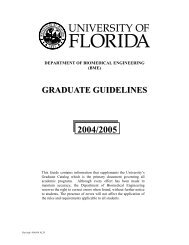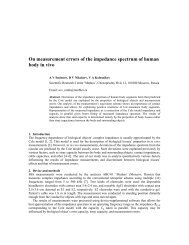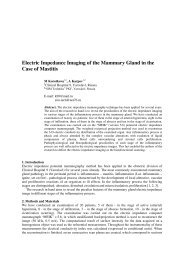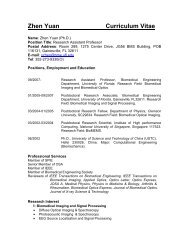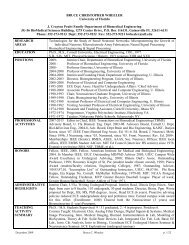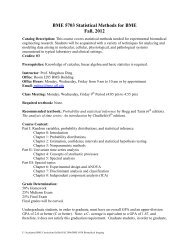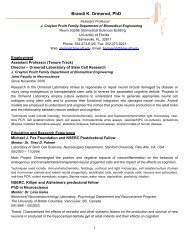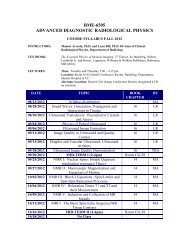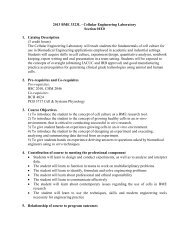Optimization of Interdigitated Electrode (IDE) Arrays ... - ResearchGate
Optimization of Interdigitated Electrode (IDE) Arrays ... - ResearchGate
Optimization of Interdigitated Electrode (IDE) Arrays ... - ResearchGate
You also want an ePaper? Increase the reach of your titles
YUMPU automatically turns print PDFs into web optimized ePapers that Google loves.
<strong>Optimization</strong> <strong>of</strong> <strong>Interdigitated</strong> <strong>Electrode</strong> (<strong>IDE</strong>) <strong>Arrays</strong> for<br />
Impedance Based Evaluation <strong>of</strong> Hs 578T Cancer Cells<br />
Frank Alexander Jr., Dorielle T. Price, Shekhar Bhansali<br />
BioMEMS and Microsystem Lab, Dept. Of Electrical Engineering, University <strong>of</strong><br />
South Florida<br />
Email: faalexan@mail.usf.edu<br />
Abstract. This paper examines the effect <strong>of</strong> electrode width and spacing <strong>of</strong> interdigitated<br />
electrodes (<strong>IDE</strong>s) for impedance-based cancer detection and characterization. <strong>IDE</strong>s are desired<br />
for bioimpedance measurements because their fabrication process is simple and inexpensive,<br />
and the geometry presents a potential for improved sensitivity over other microelectrode<br />
designs. Optimizing the geometry will eliminate this problem and increase the sensitivity <strong>of</strong><br />
these devices for bioimpedance measurement applications. This paper evaluates the effect <strong>of</strong><br />
<strong>IDE</strong> geometry on the sensitivity <strong>of</strong> breast cancer cell impedance measurements. Equivalent<br />
circuit data analysis was conducted to quantify and characterize the cells.<br />
1. Introduction<br />
Increasing demand for faster and more accurate diagnostic procedures has sparked trends in the<br />
development <strong>of</strong> MEMS devices for biosensing and medical diagnostics. MEMS are desirable for use<br />
within medical diagnostics for their ability to manipulate and analyze small volumes <strong>of</strong> biological<br />
materials. Biosensors can be incorporated into portable lab-on-a-chip devices which will be able to<br />
quickly run diagnostics on samples. These techniques improve on current cancer detection techniques<br />
because they do not require surgery or chemical tags and can shorten the time to diagnosis.<br />
Bioimpedance-based sensors <strong>of</strong>fer an inexpensive, label-free solution for MEMS-based<br />
medical diagnostics and cell and tissue research which will enable non-invasive, real-time monitoring.<br />
Bioimpedance monitoring has already been employed to study cellular kinetics [1], cancer drug<br />
screening [2], and cellular adhesion [3]. One <strong>of</strong> the most important factors to be considered when<br />
designing cellular impedance sensors is electrode geometry.<br />
Currently, interdigitated electrodes (<strong>IDE</strong>s) are implemented in various sensing devices<br />
including surface acoustic wave (SAW) sensors, chemical sensors as well as current MEMS<br />
biosensors [4]. <strong>IDE</strong>s have been optimized for a variety <strong>of</strong> sensing applications including biosensors<br />
sensors, acoustic sensors, and chemical sensors; however, optimization for cancer cell detection has<br />
yet to be reported. The output signal strength <strong>of</strong> <strong>IDE</strong>s is controlled through careful design <strong>of</strong> the active<br />
area, width, and spacing <strong>of</strong> the electrode fingers. Min et al., for example, examined the relationship<br />
between signal to noise ratio and different aspects <strong>of</strong> <strong>IDE</strong> geometry and composition for optimizing<br />
oxidation and reduction reactions <strong>of</strong> potassium ferro/ferrihexacyanide. It was found that increasing the<br />
number <strong>of</strong> electrode fingers and their finger widths yielded a proportional increase in overall signal.<br />
Also, it was found that increasing electrode thickness yielded an increase in current and overall signal<br />
with small increases in signal noise. This increase in current is thought to be due to increased surface<br />
area [5]. Another example <strong>of</strong> <strong>IDE</strong> optimization was performed by Radke et al. in [6]. Through<br />
simulations, it was found that the optimal <strong>IDE</strong> electrode finger width and spacing were 3 and 4um,
espectively, for enhanced detection <strong>of</strong> bacteria. Radke et al. demonstrated that careful design <strong>of</strong> the<br />
electrode spacing influenced the penetration depth <strong>of</strong> the electric field thus concentrating it around the<br />
captured bacteria instead <strong>of</strong> the bulk solution.<br />
Research indicates that currently, a design model for <strong>IDE</strong>s with an application in cancer cell<br />
detection and characterization does not exist. Because design criteria for <strong>IDE</strong>s vary by application a<br />
design rule for cell monitoring and characterization must be provided in order to maximize the<br />
sensitivity <strong>of</strong> bioimpedance measurements. In order to address this need, microelectrode devices were<br />
fabricated with constant electrode ectrode finger widths and varying electrode finger spacings <strong>of</strong> 15, 30 and 60<br />
microns. Bioimpedance measurements were then made on carcinoma cells deposited on these devices.<br />
This paper examines the impact <strong>of</strong> varying electrode spacing on the measured bioimpedance <strong>of</strong> the<br />
cancerous cellular monolayer.<br />
2. Materials and Methods<br />
2.1 <strong>IDE</strong> Fabrication<br />
Gold <strong>IDE</strong>s were patterned on 4-inch glass substrates using photolithography and metal deposition<br />
techniques. Fig. 1 illustrates the fabricated interdigital electrodes. First the wafers were cleaned using<br />
acetone and methanol. Next, the interdigital electrodes and contact pads were patterned using 3000PY<br />
photoresist. A thin layer <strong>of</strong> chromium (15nm) then gold (20nm) was electron beam evaporated onto<br />
the substrate. The photoresist oresist layer was then removed using acetone and ultrasonic agitation. Finally,<br />
a passivation ation layer was patterned using SU-8<br />
photoresist. This step leaves only the electrodes and<br />
contact pads exposed. This layer <strong>of</strong> photoresist is then<br />
hard baked to create an inert polymer resin.<br />
The<br />
devices were then diced and 6mm cultivation<br />
chambers were attached and sealed using slowly<br />
heated photoresist around the outer edges <strong>of</strong> the<br />
chamber.<br />
Figure 1: Schematic <strong>of</strong> <strong>IDE</strong> device<br />
2.2 Cell Culturing Protocol and Sample Preparation<br />
HS 578T breast tumor cells (ATCC) were cultured at<br />
37°C and 5% CO 2 in Dulbecco’s Modified Eagle<br />
Medium (DMEM) supplemented with 10 ng/ml<br />
epidermal growth factor (EGF), gentamicin, and 10%<br />
fetal bovine serum at final concentration. The cells<br />
were subcultured at 95% confluence and medium was changed every 2-3 days. Devices were cleaned<br />
with detergent, sterilized using 70% IPA and rinsed with Dulbecco’s Phosphate Buffer Saline (DPBS).<br />
Next, the devices were precoated with .02% gelatine solution. The solution was allowed to coat the<br />
electrodes for 20 minutes and removed prior to cellular inoculation. Cells were tripsinized using a<br />
25% trypsin solution and harvested. Devices were then inoculated with approximately 134ul <strong>of</strong> cell<br />
suspension with a concentration <strong>of</strong> 14.67 x 10 4 cells/ml. 200ul <strong>of</strong> medium was then added to the<br />
culture chambers. A minimum incubation period <strong>of</strong> 24 hours was allowed to ensure proper adherence<br />
<strong>of</strong> the cells to the electrodes prior to impedance measurements.<br />
2.3 Impedance Testing Procedure<br />
Impedance measurements were made using an Agilent 4294A impedance analyzer. A voltage <strong>of</strong><br />
10mV was applied to the contact pads using gold probe tips. No DC bias was applied and impedance<br />
magnitude and phase were collected over a frequency range <strong>of</strong> 100 Hz to 10 MHz. Standard<br />
calibration <strong>of</strong> the system was done using protocol from the manufacturer. Baseline measurements
were performed first using only medium, followed by cellular impedance measurements. The increase<br />
<strong>of</strong> impedance was observed as well as the phase shift.<br />
3. Results and Discussion<br />
Measurements were first performed with medium only in the devices. Figure 2 is a bode magnitude<br />
plot <strong>of</strong> the devices with spacings <strong>of</strong> 15, 30, and 60 µm. The slope, covering the majority <strong>of</strong> the<br />
frequency spectrum, is characteristic <strong>of</strong> the double layer capacitance at the electrode interface, caused<br />
by the absorption <strong>of</strong> ions/molecules from the medium onto the surface <strong>of</strong> the electrodes. At the high<br />
frequency end, a plateau begins to form, which is representative <strong>of</strong> the solution resistance. It can be<br />
seen from the plot that the devices with larger spacings have the greatest impedance. This is expected<br />
because the total electrode area exposed to medium is less than that <strong>of</strong> the devices with smaller<br />
spacings. Equation (1) is a simplified equation for theoretical calculation <strong>of</strong> the double layer<br />
capacitance. When the surface area increases, the capacitance increases, and the impedance decreases,<br />
ε A<br />
since it is inversely proportional to the capacitance: C o<br />
ε<br />
= r<br />
. The solution resistance also<br />
d<br />
ρ l<br />
increases with increased device spacing, in accordance with the simplified equation: R s<br />
= .<br />
A<br />
As the spacing between the <strong>IDE</strong> fingers increase, the solution resistance should also increase;<br />
as demonstrated in the bode magnitude plot in Figure 2 and in Table 1. Parameters were extracted<br />
using a constant phase element (CPE) and resistor in series, representing the double layer capacitance<br />
and the solution resistance.<br />
10 5<br />
15um spacing - Medium.txt<br />
30um spacing - Medium.txt<br />
60um spacing - Medium.txt<br />
0<br />
-15<br />
15um spacing - Medium.txt<br />
30um spacing - Medium.txt<br />
60um spacing - Medium.txt<br />
Log <strong>of</strong> Impedance in Ω<br />
10 6 Log <strong>of</strong> Frequency in Hertz<br />
10 4<br />
10 3<br />
Phase Angle in Degrees<br />
-30<br />
-45<br />
-60<br />
10 2<br />
-75<br />
10 1<br />
10 2 10 3 10 4 10 5 10 6<br />
-90<br />
10 2 10 3 10 4 10 5 10 6<br />
Log <strong>of</strong> Frequency in Hertz<br />
Figure 2: Bode magnitude plot <strong>of</strong> medium across <strong>IDE</strong>s with different spacings<br />
Table 1: Extracted parameters for medium and cells, and the difference between the measured data<br />
Medium<br />
Cells<br />
Diff<br />
Rs (Ω)<br />
Cdl (F)<br />
ndl<br />
Rs (Ω)<br />
Cdl (F)<br />
ndl<br />
Rs (Ω)<br />
15um spacing<br />
37.1<br />
1.61E-07<br />
0.91<br />
223<br />
1.63E-07<br />
0.91<br />
186<br />
30um spacing<br />
77.4<br />
8.29E-08<br />
0.90<br />
198<br />
9.56E-08<br />
0.88<br />
121<br />
60um spacing<br />
155<br />
7.83E-08<br />
0.90<br />
154<br />
1.42E-07<br />
0.83<br />
-1.0
10 5<br />
15um spacing - Cells.txt<br />
30um spacing - Cells.txt<br />
60um spacing - Cells.txt<br />
0<br />
-15<br />
15um spacing - Cells.txt<br />
30um spacing - Cells.txt<br />
60um spacing - Cells.txt<br />
Log <strong>of</strong> Impedance in Ω<br />
10 6 Log <strong>of</strong> Frequency in Hertz<br />
10 4<br />
10 3<br />
Phase Angle in Degrees<br />
-30<br />
-45<br />
-60<br />
10 2<br />
-75<br />
10 1<br />
10 2 10 3 10 4 10 5 10 6<br />
-90<br />
10 2 10 3 10 4 10 5 10 6<br />
Log <strong>of</strong> Frequency in Hertz<br />
Figure 3: Bode magnitude plot <strong>of</strong> cells across <strong>IDE</strong>s with different spacings<br />
With the presence <strong>of</strong> cells, the solution resistance increases, as seen in Figure 3 and Table 1. The ‘diff’<br />
column in Table 1 shows the calculated difference between measurements with and without cells. The<br />
largest change in resistance is seen in the 15µm-spacing devices. This experimentally validates<br />
Radke’s theory [6] that smaller <strong>IDE</strong> electrode spacing (on the order <strong>of</strong> cell size) is more sensitive to<br />
the presence <strong>of</strong> cells due to the concentrated penetration depth.<br />
4. Conclusion<br />
It can be seen from the results that the measured solution resistance increases along with the effective<br />
area <strong>of</strong> the interdigitated electrodes. By decreasing the electrode spacing the effective electrode area is<br />
increased causing an increase in the sensitivity <strong>of</strong> the device. This increase in sensitivity can be<br />
utilized to more accurately quantify modifications within cellular culture environment due to<br />
contamination, the introduction <strong>of</strong> experimental compounds and population changes.<br />
References<br />
[1] J. Wegener, C. R. Keese, and I. Giaever, "Electric Cell-Substrate Impedance Sensing (ECIS)<br />
as a Noninvasive Means to Monitor the Kinetics <strong>of</strong> Cell Spreading to Artificial Surfaces,"<br />
Experimental Cell Research, vol. 259, pp. 158-166, 2000.<br />
[2] D. Kloß, R. Kurz, H.-G. Jahnke, M. Fischer, A. Rothermel, U. Anderegg, J. C. Simon, and A.<br />
A. Robitzki, "Microcavity array (MCA)-based biosensor chip for functional drug screening <strong>of</strong><br />
3D tissue models," Biosensors and Bioelectronics, vol. 23, pp. 1473-1480, 2008.<br />
[3] C. R. Keese and I. Giaever, "A biosensor that monitors cell morphology with electrical fields,"<br />
Engineering in Medicine and Biology Magazine, IEEE, vol. 13, pp. 402-408, 1994.<br />
[4] A. V. Mamishev, "Interdigital Sensors and Transducers," Proceedings <strong>of</strong> the IEEE, vol. 92,<br />
pp. 808-845, August 26, 2009 2004.<br />
[5] J. Min and Antje J. Baeumner, "Characterization and <strong>Optimization</strong> <strong>of</strong> <strong>Interdigitated</strong><br />
Ultramicroelectrode <strong>Arrays</strong> as Electrochemical Biosensor Transducers," Electroanalysis, vol.<br />
16, pp. 724-729, 2004.<br />
[6] S. M. Radke and E. C. Alocilja, "Design and fabrication <strong>of</strong> a microimpedance biosensor for<br />
bacterial detection," Sensors Journal, IEEE, vol. 4, pp. 434-440, 2004.



